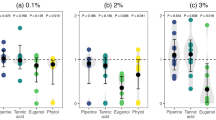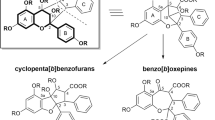Abstract
The defensive chemistry of two species of ants from Brunei in the genus Crematogaster (Physocrema group) has been investigated. Ants in this group release a white secretion from hypertrophied metapleural glands on their thorax when they are disturbed. Previously, one species in this group has been shown to produce alkylphenols and alkylresorcinols. In the present investigation, similar compounds along with salicylic acids and resorcylic acids that are anacardic acid and olivetolic acid homologs, respectively, are described from two species. The structures of these compounds were suggested by their spectroscopic data and confirmed by direct comparison with synthetic samples. Some of these compounds occur in lichens and have well documented physiological activities.
Similar content being viewed by others
References
Attygalle, A. B., Siegal, B., Vostrowsky, O., Bestmann, H. J., and Maschwitz, U. 1989. Chemical composition and function of metaplural gland secretion of the ant Crematogaster deformis Smith (Hymentoptera: Myrmicinae). J. Chem. Ecol. 15:317–328.
Beattie, A. J., Turnbull, C. L., Hough, T., and Knox, R. B. 1986. Antibiotic production: A possible function for the metapleural glands of ants (Hymenoptera: Formicidae). Ann. Entomol. Soc. Am. 79:448–450.
Begum, P., Hashidoko, Y., Islam,Md., T., Ogawa, Y., and Tahara, S. 2002. Zoosporicidal activities of anacardic acids against Aphanomyces cochloides. Z. Naturforsch. 57c:874–882.
BRAND, J. M. and PRETORIUS, V. 1986. Individual variation in the major alarm pheromone components of two Crematogaster species. Biochem. Syst. Ecol. 14:341–343.
CREWE, R. M., BRAND, J. M., and FLETCHER, D. J. C. 1969. Identification of an alarm pheromone in the ant Crematogaster peringueyi. Ann. Entomol. Soc. Am. 62:1212.
Crewe, R. M., Brand, J. M., Fletcher, D. J. C., and Eggers, S. H. 1970. The mandibular gland chemistry of some South African species of Crematogaster (Hymentoptera: Formicidae). J. Georgia Entomol. Soc. 5:42–47.
Daloze, D., Braekman, J. C., Vanhecke, P., Boeve, J. L., and Pasteels, J. M. 1987. Long chain electrophilic contact poisons from the Dufour’s gland of the ant Crematogaster scutellaris (Hymenoptera, Myrmicinae). Can. J. Chem. 65:432–436.
Daloze, D., de Biseau, J.-C., Leclercq, S., Braekman, J.-C., Quinet, Y., and Pasteels, J. M. 1998. (13E,15E,18Z,20Z)-1-Hydroxypentacosa-13,15,18,20,-tetraen-11-yn-4-one 1-acetate, from the venom of a Brazilian Crematogaster ant. Tetrahedron Lett. 39:4671–4672.
Djura, P. and Sargent, M. V. 1976. Depsidone synthesis. III grayanic acid. Aust. J. Chem. 29:899–906.
Elix, J. A. 1974. Synthesis of para-olivitol depsides. Aust. J. Chem. 27:1767–1779.
Elix, J. A., Barclay, C. E., and Lumbsch, H. T. 1994. New depsides from the lichen Lecanora planaica. Aust. J. Chem. 47:1199–1203.
Forel, A. 1912. Formicides néotropiques. Part 3. 3me sous-famille Myrmicinae (suite). Genres Cremastogaster et Pheidole. Mémoires de la Société Entomologique de Belgique 19:179–237.
Fujikawa, F., Nakajima, K, Sawaguchi, H., Takimura, M., Nakazawa, S., Omatsu, T., and Toyoda, T. 1953. Antibacterial activity of some organic compounds in vitro. IV. Yakugaku Zasshi 73:537–540.
Gaucher, G. M. and Shepherd, M. G. 1971. Orsellinic acid. Biochem. Prep. 13:70–74.
Hauser, F. M. and Ellenberger, S. R. 1987. Regiospecific oxidation of methyl groups in dimethylanisoles. Synthesis 723–724.
Hauser, F. M. and Pogany, S. A. 1980. 2-Hydroxy-6-methylbeozoic acid derivatives. Synthesis 814–815.
Hölldobler, B. and Wilson, E. O. 1990. The Ants. The Belknap Press of Harvard University Press, Cambridge MA, USA. 244 p.
Kubo, I., Muroi, H., and Himejima, M. 1993. Structure-antibacterial activity relationships of anacardic acids. J. Agric. Food. Chem. 41:1016–1019.
Laurent, P., Hamdani, A., Braekman, J. C., Daloze, D., Isbell, L. A., de Biseau, J. C., and Pasteels, J. M. 2003. New 1-alk(en)-1,3,5-trihydroxycyclohexanes from the Dufour gland of the African ant Crematogaster nigriceps. Tetrahedron Lett. 44:1383–1386.
Leclercq, S., Braekman, J. C., Kaisin, M., Daloze, D., Detrain, C., de Biseau, J. C., and Pasteels, J. M. 1997. Venom constituents of three species of Crematogaster ants from Papua New Guinea. J. Nat. Prod. 60:1143–1147.
Leclercq, S., de Biseau, J. C., Daloze, D., Braekman, J. C., and Pasteels, J. M. 2000a. Five new furanocembranoids from the venom of the ant Crematogaster brevispinosa ampla form Brazil. Tetrahedron Lett. 41:633–637.
Leclercq, S., de Biseau, J. C., Braekman, J. C., Daloze, D., Quinet, Y., Luhmer, M., Sundin, A., and Pasteels, J. M. 2000b. Furanocembranoid diterpenes ass defensive compounds in the Dufour gland of the ant Crematogaster brevispinosa rochai. Tetrahedron 56:2037–2042.
Leuthold, R. H. and Schlunegger, U. 1973. The alarm behavior from the mandibular gland secretion in the ant Crematogaster scutellaris. Insectes Soc. Paris. 20:205–214.
Lloyd, H. A., Evans, S. L., Khan, A. H., Tschinkel, W. R., and Blum, M. S. 1978. 8-Hydroxyisocoumarin and 3,4-dihydro-8-hydroxyisocoumarin in the defensive secretion of the tenebrionid beetle, Apsena pubescens. Insect Biochem. 8:333–336.
Maschwitz, U., Koob, K., and Schildknecht, H. 1970. Ein Beitrag zur Funktion der Metathoracaldrüse de Ameisen. J. Insect Physiol. 16:387–404.
Matsumoto, T. and Sei, T. 1987. Antifeedant activities of Ginkgo biloba L. components against the larva of Piersi rapae crucivora. Agric. Biol. Chem. 51:249–250.
Muroi, H. and Kubo, I. 1993. Bactericidal activity of anacardic acids against Streptococcus mutans and their potentiation. J. Agric. Food Chem. 41:1780–1783.
Nist/Epa/Nih. 1999. Mass spectral library on CD-ROM, version 1.7. Gaithersburg, MD. Copyright by U.S. Secretary of Commerce.
Pasteels, J. M., Daloze, D., and Boeve, J. L. 1989. Aldehydic contact poisons and alarm pheromone of the ant Crematogaster scutellaris (Hymenoptera: Myrmicinae). J. Chem. Ecol. 15:1501–1511.
Schlunegger, U. and Leuthold, R. H. 1972. Rapid identification of volatile compounds in insects with a direct gas chromatography/mass spectrometry procedure: 3-Octanone and 3-octanol in Crematogaster scutellaris and C. ashmedi. Insect Biochem. 2:150–152.
Scheffrhan R. H. and Rust, M. K. 1989. Attraction by semiochemical mediators and major exocrine products of the Myrmicine ant, Crematogaster californica Emery. Southwestern Entomol. 14:49–55.
Tyman, J. H. P. 1979. Non-isoprenoid long chain phenols. Chem. Soc. Rev. 8:499–537.
Tyman, J. H. P. and Visani, N. 1997. Synthesis of saturated anacardic acids and alkenyl and alkynyl analogs. J. Chem. Res. (S). 14–15.
Walters, D. S., Minard, R., Craig, R., and Mumma, R. O. 1988. Geranium defensive agents III. Structural determination and biosynthetic considerations of anacardic acids of geranium. J. Chem. Ecol. 14:743–751.
Wedekind, E. and Fleischer, K. 1923. Über die konstitutiondes Sparassols. Chem. Ber. 56:2556–2563.
Author information
Authors and Affiliations
Corresponding author
Rights and permissions
About this article
Cite this article
JONES, T.H., BRUNNER, S.R., EDWARDS, A.A. et al. 6-Alkylsalicylic Acids and 6-Alkylresorcylic Acids from Ants in the Genus Crematogaster from Brunei. J Chem Ecol 31, 407–417 (2005). https://doi.org/10.1007/s10886-005-1349-6
Received:
Accepted:
Issue Date:
DOI: https://doi.org/10.1007/s10886-005-1349-6




